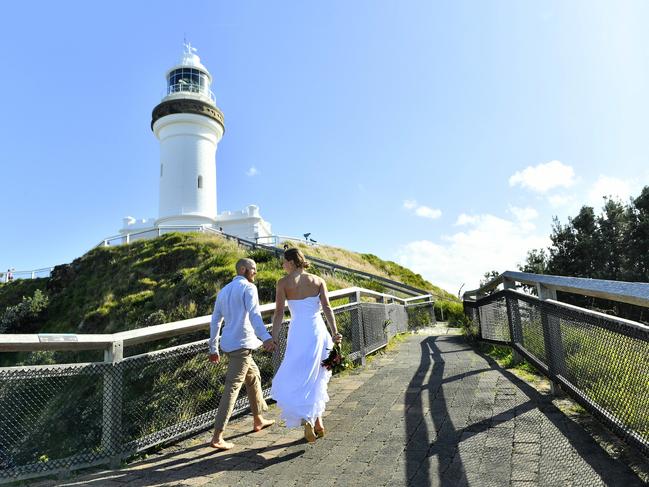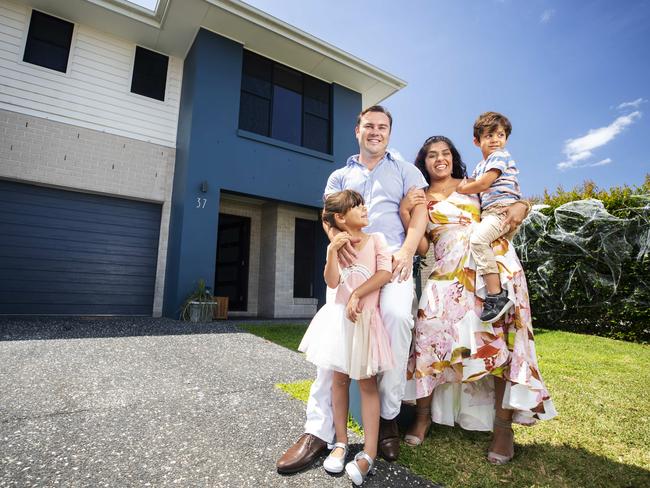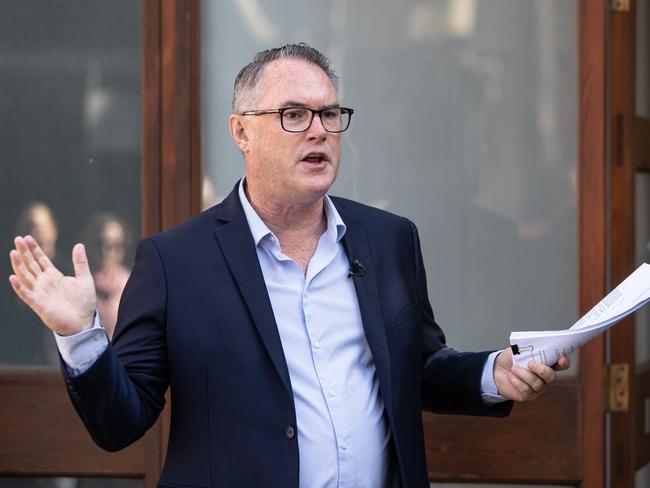Why Byron Bay has lost its shine
Traditional regional hotspots like Byron Bay are losing their appeal across Australia as lesser known ‘ripple regions’ boom.
Property
Don't miss out on the headlines from Property. Followed categories will be added to My News.
It’s one of the most fundamental shifts in the Australian psyche in recent history: city slickers who’d never seriously considered making the move to a regional area before suddenly had their eyes opened to the idea en masse.
Enticed by the promise of getting more bang for their buck and more flexible working arrangements introduced during the Covid-19 pandemic, they exited the big smoke in droves.
And they weren’t leaving behind things like top quality restaurants in the process — with high-profile chefs increasingly preferring to work close to where they source their produce, and foodies becoming spoiled for choice in places like Byron Bay, Orange, the Tweed and the Sunshine Coast.

A trend that began with the seachangers and treechangers of decades past was magnified by what demographer Bernard Salt coined VESPAs – Virus Escapees Seeking Provincial Australia.
The population of regional Australia grew by more than 100,000 in FY22, building on 70,000 the year before.
The impact this trend has had on these regional areas cannot be understated, with unprecedented jobs growth and more money being poured into the regions leading to improved services and infrastructure and greater liveability.
Property values soared too, creating an attractive market for investors.
The average distance between where landlords live and invest is reportedly now 857km, compared with 559km in the year to November 2021, and 294km pre-pandemic, according to data from MCG Quantity Surveyors.

The move towards remote investing has largely been driven by the perception of better capital growth prospects in the regions, and higher rental yields that usually come with more affordable properties.
Another benefit of buying in regional areas is the opportunity to buy houses, which have historically delivered better capital growth than apartments, which are the only affordable option for many investors in the capital cities.
With banks charging higher interest rates on investor loans, these investors are also being forced to look towards more affordable markets.
Advancements in technology necessitated by the pandemic, such as video inspections, 3D floorplans and signing contracts electronically, have also enabled this trend. The prospect of phone bidding and purchasing properties sight unseen is no longer foreign.

THE RIPPLE EFFECT
Buyers lured to the regions – whether investors or owner occupiers – who found themselves priced out of hotspots, have started to look in neighbouring ‘ripple regions’ where the lifestyle is similar but more affordable.
For example, while the median price of houses in ever-popular Byron Bay fell 8.7 per cent over the 12 months to June 2023 to be $2.875 million, other nearby towns that offer excellent value a bit further from the coast have fared considerably better.
In the hinterland town of Clunes, the median house price rose 6.1 per cent to $1.35 million, while in Nimbin it rose 2.3 per cent to $655,000.

On Queensland’s Sunshine Coast, house prices in Noosa Heads rose by 5.8 per cent to $2,157,500 in the 12 months to June, but there were more dramatic increases a bit further inland.
House values in Kin Kin shot up 21.5 per cent to $1,032,500, while in Black Mountain they climbed 24.4 per cent to $1,244,000. On Victoria’s Mornington Peninsula, median house prices in highly sought-after Portsea dipped 11.7 per cent over the same period to $3.4 million.
But elsewhere buyers have turned to relatively affordable areas such as seaside Dromana, which has seen a 2.6 per cent increase to $1,100,500, and neighbouring McCrea, which has increased 3.1 per cent to $1,299,5008.

Rental growth has slowed in regional markets across the country, down from a record overall monthly growth rate of 1.2 per cent in March 2022, to 0.3 per cent in May 2023.
Nevertheless, since the onset of the pandemic, rental growth in the regions has outstripped the capital cities, climbing 29.2 per cent to June.
POPULATION BOOM
The population boom in rural Australia is leading to strong employment growth, with regional job advertisements growing three times faster than in metropolitan Australia at the end of 2022.
Demand for labour in regional areas was highest in Queensland, followed by NSW and South Australia. With more people paying rates in regional Australia, this is also leading to greater liveability as councils have more money to spend on footpaths, playgrounds and sporting facilities.

A range of exciting new infrastructure projects is also bound to draw even more people to the regions.
On the fast-growing Sunshine Coast, $300 million is being spent to create Australia’s first ‘smart city’ at Maroochydore.
The country’s largest greenfield development will feature a mix of apartments, restaurants, a hotel, shops and parks, with the fastest available international data connections and free Wi-Fi hotspots.
The Comiskey Group is splashing out $35 million to build the Sunshine Coast’s biggest music venue.
Set to open in the Aura development, near Caloundra, in late 2024, it will be capable of holding 2500 people, with restaurants, bars and function spaces.

The company is also creating a Coachella-style outdoor festival site on 150ha of disused turf and strawberry farms south of Caloundra. Named Coochin Fields, the site is a similar size to North Byron Parklands, which hosts large-scale annual events like Splendour in the Grass and the Falls Music & Arts Festival.
In NSW’s Central Tablelands region there are plans for a $35 million sports complex on the site of the Orange Ex-Services’ Country Club golf course, featuring a field for rugby league, union and football games, and an oval for AFL and cricket to foster emerging sporting talent.
The NSW Government is also spending nearly $60 million on improving racing infrastructure across regional NSW, with Scone, Gosford and Cessnock the biggest recipients so far.

There are some exciting housing developments in the state, such as the Temora Airpark Estate beside the aerodrome in the Riverina town, where aviation enthusiasts can park their planes in their own hangars next to their houses and taxi to the runway just a few hundred metres away.
More than $4 billion has been invested in Victoria’s Regional Rail Revival program, which is upgrading every regional passenger train line in the state, with beneficiaries including Ballarat, Bendigo-Echuca and Geelong.
Across regional Victoria, disused train lines are slowly being converted into shared paths for walkers and cyclists.
The Great Southern Rail Trail, which winds through the historical towns of East Gippsland, is being extended to 130km, making it one of the longest in Australia.

The $46.8 million Surf Coast Aquatic and Health Centre is also set to open at Torquay, on Victoria’s Great Ocean Road, in 2026.
In Tasmania, the northern city of Devonport is being revitalised as part of the Living City project, with a new $55 million waterfront precinct including a hotel, amphitheatre, events common, parks, playgrounds and pathways.
A spectacular sound and light show will provide nightly entertainment for locals and tourists.
There’s no doubt that it’s an exciting time for regional Australia, with the work-from-home generation benefiting from the opportunity to live a better life away from major metropolises and the chance for many more to follow as property prices and rents stabilise.
* John McGrath is the founder, managing director and chief executive officer of McGrath Estate Agents
Originally published as Why Byron Bay has lost its shine




